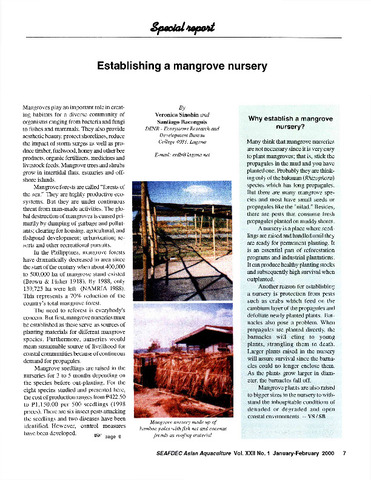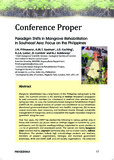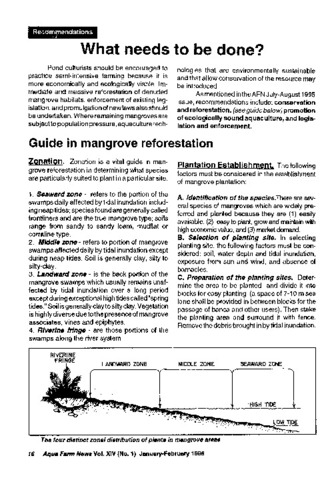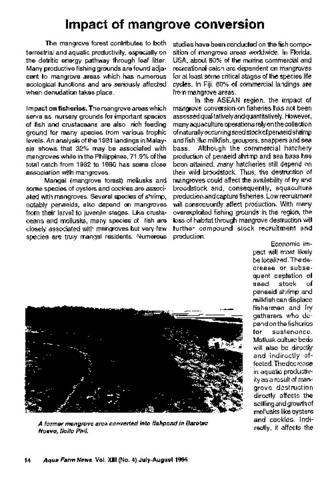Establishing a mangrove nursery
Share
Abstract
Mangroves play an important role in creating habitats for a diverse community of organisms ranging from bacteria and fungi to fishes and mammals. They grow in intertidal flats, estuaries and offshore islands. In the Philippines, mangrove forests have dramatically decreased in area since the start of the century, and therefore there is a need to reforest. However, first mangrove nurseries must be established since they serve as sources of planting materials for different mangrove species. Furthermore, nurseries would mean a sustainable source of livelihood for coastal communities because of continuous demand for propagules. A brief account is given of procedures as to the establishment of a mangrove nursery, describing the construction of a nursery, preparation of potting materials, seed collection, seed sowing, and maintenance and protection. Details are provided of the most common true mangrove species in the Philippines. The mangrove nursery is a place for raising and tending seedlings until they are ready for permanent planting. The establishment of mangrove nurseries is in line with government s efforts to rehabilitate the coastal and mangrove ecosystems.
Suggested Citation
Sinohin, V., & Baconguis, S. (2000). Establishing a mangrove nursery. SEAFDEC Asian Aquaculture , 22(1), 7-8, 28-30. http://hdl.handle.net/10862/1773
Subject
Collections
Related items
Showing items related by title, author, creator and subject.
-
Paradigm shifts in mangrove rehabilitation in Southeast Asia: Focus on the Philippines
Primavera, Jurgenne H.; Guzman, Armi May T.; Coching, Jofel D.; Loma, Rona Joy A.; Curnick, David; Koldewey, Heather J. (Department of Environment and Natural Resources - Ecosystems Research and Development Bureau (DENR-ERDB), 2014)Mangrove rehabilitation has a long history in the Philippines dating back to the 1930s. The standard practice is the planting of bakhaw Rhizophora propagules by paid community members (or volunteers) in seafront sites ... -
What needs to be done?: Guide in mangrove reforestation
Southeast Asian Fisheries Development Center, Aquaculture Department (Aquaculture Department, Southeast Asian Fisheries Development Center, 1996)The article presents a two-part guideline in mangrove reforestation. The first part is zonation, which is the process of determining what species are particularly suited to plant in a particular site. While, plantation ... -
Impacts of mangrove conversion
Southeast Asian Fisheries Development Center, Aquaculture Department (Aquaculture Department, Southeast Asian Fisheries Development Center, 1995)The article presents the impact of mangrove conversion on fisheries and on coastal areas. The mangrove areas which serve as nursery grounds for important species of fish and crustaceans are also rich feeding ground for ...





